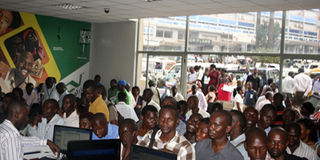Prime
Why is your favourite TV station off air?

Customers line up to pay for decoders and Satellite TV services in Kampala on Monday. Many Ugandans were affected after their TVs were switched off at the weekend. Photo by Stephen Otage.
What you need to know:
Although the communications regulator, UCC, gave prior warning about switching off analogue transmission, many people still do not understand why.
Kampala - Last Saturday morning, many Uganadans woke up to the shock of having some of their favourite TV stations off air.
Most were oblivious of the developments announced by the Uganda Communications Commission and the Ministry of Information, through a press release on Thursday and Friday last week.
The press release had it that 19 television and radio stations using the Signal Distribution services of Uganda Broadcasting Corporation at Kololo, would, with effect from August 10, starting 8am to August 12 at 6pm, have their signals turned off.
This was to allow the installation of equipment for Digital Terrestrial Transmission Broadcasting meant to enable the migration from analogue to digital broadcasting.
What is digital migration and what does it primarily mean to the analogue user? Is it a ploy to dig further into the pockets of Ugandans by adding video entertainment to the monthly bill as most argue or a transition to clearer transmission as communication bodies say?
According to Mr Fred Otunnu, the spokesperson of the Uganda Communications Commission, digital migration is the switch from an analogue broadcasting system to a digital broadcasting system. This has been driven by the International Telecommunications Union. All countries are required to switch from an analogue to a digital television broadcasting signal by June 2015.
“In simple terms, the migration implies a shift from using the analogue plug-in antennae, to the use of digital transmitters accessed through a set top box (or decoder), where one can enjoy clear images,” he says.
He adds that some of the latest models of television sets, for instance LED screen TVs, and those that have the “digital eye” label, possess the technology that transforms analogue transmissions to digital. “These, however, are hard to find.”
Safety measures
According to Mr Paul Kihika, the managing director of the Uganda Broadcasting Corporation (UBC), the stations were switched off primarily for safety and pre-cautionary measures while officials install the equipment.
Installation of equipment cannot be done when electricity in the area is running. The UBC engineers were at the site installing the antennae and a combiner — a machine which merges both analogue and digital signals.
The stations affected included BBC radio, East African Radio and television, Lighthouse Television, Citizen TV, NBS, ITV, Channel 44, WBS, NTV, Record TV, Sanyu FM, Super FM, Top Radio and TV among others.
“Only stations whose antennae are above 100m at the mast were affected while those below and elsewhere were not affected,” Mr Fred Otunnu, the UCC spokesperson, said.
-----
What Digital broadcasting is all about
DVBT is Terrestrial Digital Video Broadcasting. It has evolved from phase 1 to phase 2; DVBT1 and DVBT2, with the latter being the improved versions.
This technology was first publicised in 1997, when it was plainly termed DVBT.
It possesses the ability to transmit a significant amount of data.
Normally, several television broadcasts may be carried on a single transmission and in addition to this several audio channels may be carried as well. As a result, each transmission is called a multiplex.
This technology underwent developments over the years that led to the improved DVBT2 technology, one that provides up to 50 per cent more efficiency and clarity in video and audio transmission.
With such technology, picture video transmissions are as clear as watching something live, with no hiccups or disruptions.
That is the clarity that DVBT2 promises
Why digital?
According to Mr Otunnu, the pros of digital transmission are countless.
“First, it implies better image for TV and better audio quality in the case of the radios. One can witness how the cable transmitters (such as DSTV, Star Times, Go TV, Zuku TV), that use Digital transmission over the usual turn-on analogue stations,” he says.
He adds that it significantly reduces transmission costs for the stations, enabling them to focus on provision of better programming for their audiences.




